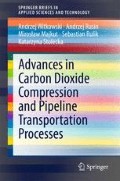Abstract
This chapter presents an analysis of the hazards and risk related to CO2 transport from power plants to potential storage sites. Potential hazardous effects of an uncontrollable release of CO2 caused by a pipeline failure are shown and the risk level in areas surrounding the pipeline is determined. It also presents a probabilistic model of corrosion wear of the pipeline walls and an assessment of the rise in the gas leakage probability. An analysis of the possibility of reducing the level risk related to pipeline transporting CO2 by means safety valves is also presented.
Access this chapter
Tax calculation will be finalised at checkout
Purchases are for personal use only
References
Abbasi T, Abbasi SA (2007) The boiling liquid expanding vapour explosion (BLEVE): mechanism, consequence assessment, management. J Hazard Mater 141:489–519
Ahammed M (1998) Probabilistic estimation of remaining life of a pipeline in the presence of active corrosion defects. Int J Press Vessels Pip 75:321–329
Benson SM (2006) Carbon dioxide capture and storage assessment of risks from storage of carbon dioxide in deep underground geological formations. Earth Sciences Division, Lawrence Berkeley National Laboratory, Berkeley
Bjerketvedt D, Egeberg K, Ke W, Gaathaug A, Vagsaether K, Nilsen SH (2011) Boiling liquid expanding vapour explosion in CO2 small scale experiments. Energy Procedia 4:2285–2292
Cameron IT, Raman R (2005) Process systems risk management. Elsevier, Amsterdam
Cole IS, Corrigan P, Sim S, Birbilis N (2011) Corrosion of pipelines used for CO2 transport in CCS: is it a real problem? Int J Greenh Gas Control 5:749–756
Condor J, Unatrakarn D, Wilson M, Asghari K (2011) A comparative analysis of risk assessment methodologies for the geologic storage of carbon dioxide. Energy Procedia 4:4036–4043
Deel D, Mahajan K (2008) Risk assessment and management for long-term storage of CO2 in geologic formations—United States Department of Energy R&D. J Syst Cybner Inform 5:79–84
Det Norske Veritas (2010) Design and operation of CO2 pipelines. Recommended practice, DNV-RP-J202
Duncan IJ, Wang H (2014) Estimating the likelihood of pipeline failure in CO2 transmission pipelines: new insights on risk of carbon capture and storage. Int J Greenh Gas Control 21:49–60
Eldevik F, Graver B, Torbergsen LE, Saugerud OT (2009) Development of a guideline for safe, reliable and cost efficient transmission of CO2 in pipelines. Energy Procedia 1:1579–1585
Gale J, Davison J (2004) Transmission of CO2—safety and economic considerations. Energy 29:1319–1328
Gerboni R, Salvador E (2009) Hydrogen transportation systems: elements of risk analysis. Energy 34:2223–2229
Koornneef J, Spruijt M, Molag M, Ramirez A, Turkenburg W, Faaij A (2010) Quantitative risk assessment of CO2 transport by pipelines—a review of uncertainties and their impacts. J Hazard Mater 177:12–27
LaChance J, Tchouvelev A, Engebo A (2011) Development of uniform harm criteria for use in quantitative risk analysis of the hydrogen infrastructure. Int J Hydrogen Energy 36:2381–2388
McGillivray A, Wilday J (2009) Comparison of risks from carbon dioxide and natural gas pipelines, HSE report no 749
McGillivray A, Saw JU, Lisbona D, Wardman M, Bilio M (2014) A risk assessment methodology for high pressure CO2 pipelines using integral consequence modelling. Process Saf Environ Prot 92:17–26
Molag M, Dam C (2011) Modelling of accidental releases from high pressure CO2 pipelines. Energy Procedia 4:2301–2307
Murvay P-S, Silea I (2012) A survey on gas leak detection and localization techniques. J Loss Prev Process Ind 25:966–973
Orazem M (2014) Underground pipeline corrosion, 1st edn. Woodhead Publishing, Amsterdam
Rosyid OA, Jablonski D, Hauptmanns U (2007) Risk analysis for the infrastructure of hydrogen economy. Int J Hydrogen Energy 32:3194–3200
Rusin A (2008) Awaryjność, niezawodność i ryzyko techniczne w energetyce cieplnej [Failure frequency, reliability and technical risk in thermal power engineering]. Wydawnictwo Politechniki Śląskiej Gliwice
Rusin A, Stolecka K (2013) Hazard to the environment caused by carbon capture and storage (CCS) technologies. Pol J Environ Stud 1:205–211
Rusin A, Stolecka K (2015) Reducing the risk level for pipelines transporting carbon dioxide and hydrogen by means of optimal safety valves spacing. J Loss Prev Process Ind 33:775–787
Shuter D, Bilio M, Wilday J, Murray L, Whitbread R (2011) Safety issues and research priorities for CCS systems and infrastructure. Energy Procedia 4:2261–2268
Sokólski W (2004) Bezpośrednia ocena procesów korozji jako element bezpieczeństwa eksploatacji rurociągów [Direct assessment of corrosion processes as an element of pipeline operation safety]. In: 7th national conference corrosion measurements in electrochemical protection, Jurata
Stewart MG, Melchers RE (1997) Probabilistic risk assessment of engineering systems. Chapman and Hall, London
Stolten D, Scherer V (2011) Efficient carbon capture for coal power plants. Wiley-VCH, Weinheim
Teixeina AP, Guedes Soares C, Netto TA, Estefen SF (2008) Reliability of pipelines with corrosion defects, Int J Press Vessel Pip 85(4):228–237
UDM Theory Document (2009) DNV software
Uliasz-Misiak B (2011) Wpływ geologicznego składowania CO2 na środowisko [Environmental impact of CO2 geological storage], Gospodarka Surowcami Mineralnymi, Book 1, vol 27, pp 129–143
Van der Voort MM, Van Wees RMM, Hamb JM, Spruijt MPN, Van der Berg AC, De Bruijn PCJ, Van Ierschot PGA (2011) An experimental study on the temperature dependence of CO2 explosive evaporation. Process Saf Environ Prot 89:482–491
Witlox HWM, Stene J, Harper M, Nilsen (2011) Modelling of discharge and atmospheric dispersion for carbon dioxide releases including sensitivity analysis for wide range scenarios. Energy Procedia 4:2253–2260
Zhang Y, Schork J, Ludwig K (2013) Revisiting the conditions for a CO2 tank explosion. In: 9th global congress of process safety
Author information
Authors and Affiliations
Corresponding author
Rights and permissions
Copyright information
© 2015 The Author(s)
About this chapter
Cite this chapter
Rusin, A., Stolecka, K. (2015). Analysis of Risk Related to Carbon Dioxide Pipeline Transport. In: Advances in Carbon Dioxide Compression and Pipeline Transportation Processes. SpringerBriefs in Applied Sciences and Technology. Springer, Cham. https://doi.org/10.1007/978-3-319-18404-3_7
Download citation
DOI: https://doi.org/10.1007/978-3-319-18404-3_7
Published:
Publisher Name: Springer, Cham
Print ISBN: 978-3-319-18403-6
Online ISBN: 978-3-319-18404-3
eBook Packages: EnergyEnergy (R0)

